I wanted to build my own solar system and I can tell you now it's possible with materials bought local in DIY shops and easy to obtain parts from the Internet. No I'm not a technical wonder and I don't have lots of experience working with electricity, I just looked around and taught myself how solar panels are made, how other might have done it and made out of this a workable plan of how I could do it.
Home Build Solar System
Hans Maas | How to Build a Solar System
The initial intention
I could see that my electricity bill was increasing year after year, just because the modern day appliances can’t be turned off any more, and before I noticed I had many appliances in the house which are on standby day in day out.
This all not only harm the environment but also my bank account as I am using electricity for nothing. Not to solve this problem (as this is how appliances are made and I can’t change this) I started to look into renewable energy to compensate my unneeded losses and to take some pain away from my bank account.
Wind energy was no option due to the area I’m living in, hydro electricity is no option as I live in a flat country with next to no rivers so solar power was the best solution. Than the price of solar systems appear to be horrendous, far too much that the system ever would produce in its estimated 20 year lifespan. So I tried to get governmental grants for this project but grants for those kinds of systems where limited and did I miss out. But I still wanted a solar system but I didn’t wanted to pay the high price, so I decided to build the panels myself.
Yes you see this right, I wanted to build my own solar system and I can tell you now it’s possible and well with materials bought local in DIY shops and easy to obtain parts from the Internet. No I’m not a technical wonder and I don’t have lots of experience working with electricity, I just looked around and taught myself how solar panels are made, how other might have done it and made out of this a workable plan of how I could do it.
Start of the challenge
After I did my homework I found out that there was a solar cell manufacturer just a few hours away from my house who could supply me with the needed cells (otherwise I could buy those online as they’re easy to obtain from other sites). With information I collected from various sources I made a wiring diagram and did I got ordinary glass from a local supplier. Tools I needed came from my local DIY store and I was ready to start. See the needed materials list below witch not only states all the needed materials but also the price I paid for it and the shop I bought them from. The material list is for one panel only and the list of the total system is for 2 panels, one inverter and production meter. Installation material like wire, junction boxes, screws and holding brackets I didn’t had to buy as those I still had in the shed or made my self.
.jpg)
List of materials I needed to make one panel and price I bought them for.
Building process
I soldered the solar cells according to the wiring diagram in series as this added the voltage of each cell together to achieve the desired (and highest) output. I made a 28 cell panel (4 strings of 7 cells) as this is fitting the best in my garden and would give me 28x0.5V=14V (theoretically). The amperage I didn’t know yet as I bought B quality cells to play around with (this saved me some expenses to mess around with).
When I finished soldering the cells, the cells where up side down (as I soldered the backside of the cells last) so could place on the back of each cell a little bid silicone and glued the cells on a 4mm glass sheet (this sheet will eventually become the back of the panel). Now I left it all to dray and the silicone to vapor out (it’s really important to let the silicone vapor out real good as the vapors react with the solder on the cells).
Next I turned the glass sheet over and placed small tile crosses (they use to place tiles on a wall or on the ground to keep a standard distance between the tiles) in between the cells so that at a later stage of the building process the 2 plates of glass will form a stiffer construction. When they are in place I did put silicone sealant all around the edge of the glass plate at a distance of about 3 cm from the edge (which I left empty for filling at a later stage).
Then I placed the other plate of glass on top of it so the cells are now sandwiched between 2 glass sheets of 4mm thick (yes I just made double glassing with solar cell imbedded, how easy can a plan be).
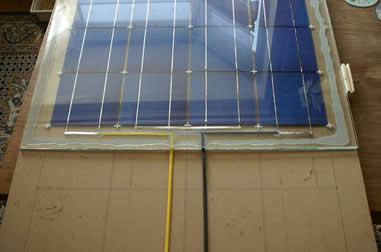
The cells sandwiched between 2 sheets of glass, you can see clearly the cells hooked in series with a - at the right (black) and + at the left (yellow).
And left it all to dry for a minimum of 24 hours, the longer the better due to the sealant vapors.
Then there is still an open space between the 2 glass plates on the outer edge and I filled this with more sealant. Now I have 2 sealant seals, so if one sealant line leaks than there is the 2nd line as a backup. I leave this to dry for another 3 days.
When the sealant has dried fully, I took some aluminum profile (aluminum angle bar) to make a frame to protect the glass and to make the panel stronger.
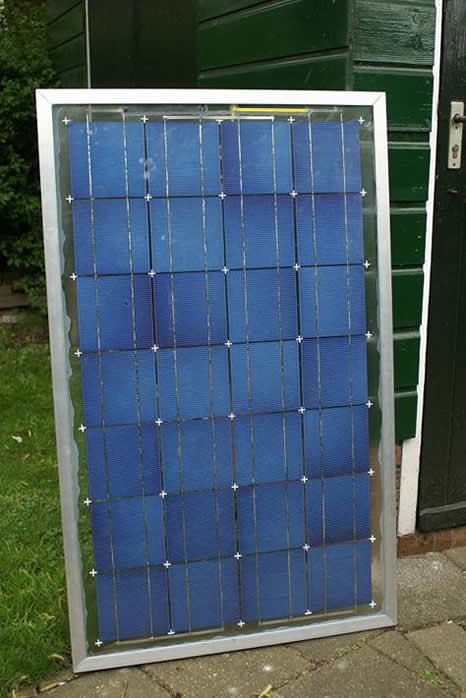
One finished panel
At the back of the panel I made a junction box with a terminal block. At one site of the block the + and – from the panel is going in and at the out side will go the wire going to the inverter. In the junction box is also an diode in between the + from the panel to the + going to the inverter, this will prevent electric current to flow to the panel when the panel is not producing any electricity (like at night).
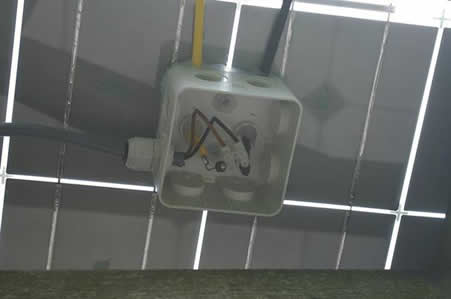
The junction box at the back of the panel with the blocking diode.
Inverter
I contacted the local solar panel shop for a suitable inverter as this one needs to be small (remember that I only make a small amount of electricity with this panel). In the shop was a small inverter laying around which could not be sold, and I could have this for free as it would otherwise be in the shop for a few more year. The inverter is an OK-4 one, starting at 24V to 50V and a max of 100W. So this learned me that just one panel would not be enough as this would give me only 14V, so I needed a 2nd one and also hooked up in series so I would get 28V which is enough to get the inverter going. The 14V appeared to be enough but you could see that this was not a strong current so guess what, I made a 3rd panel and now the production is nice and steady.
I know that this inverter can go to a max of 100W and my 3 panels give more (135Wp) but this maximum my panels give will be chocked back by the inverter. What ever the inverter gets more than he can handle is burned off as heat. Yes I know what you’re thinking; I’m wasting electricity right at the course. That’s true, but only at the middle of the day for a few hours when the sun is at it’s strongest and optimum angle to the panels and most of the day (actually most day’s) this is not the case. Now I start producing right a way when the sun comes up till it’s going down, just thanks to the fact that this inverter is able to work at a low voltage. I gain more by producing in total at the lower range (every day) than a few hours (at some day’s) at the top range.
Figure facts
As that the OK-4 inverter hasn’t got a build-in display to see how much output it gives I needed a separate production meter. A guess what, I was also not prepared to pay the full “solar panel world price” for this neither. I went to a local DIY store and bought an ELRO M12 Power Calculator, which is actually mend for calculating the usage of electrical appliances but works also fine to calculate any solar production (this calculator is working both ways it can give and take electricity from the net). And this calculator plugs straight into the mains power supply with no difficult wiring (that’s what we need).
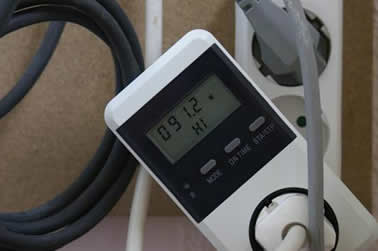
The ELRO M12 production meter with 91W of home build solar power.
Factory figures gave me that each cell gives 0.5V x 6A = 3Wp, but this in the perfect circumstances. For a whole panel this would mean 28 cells x 3Wp = 84Wp. But from previous gained knowledge I know that this is always given as an to optimistic figure and that around 20% less production will be achieved in real live. In this case this would mean a true expected production figure of 67Wp.
My panels are certainly not facing the optimum way, but this is for now also not the meaning (as silly as it sounds).
The panels are placed at a 10 degree angle (instead 35) and not exactly facing South. But where they are placed is a temporary installation with the reason that I want to see how they’re behaving in real weather with cold temperatures, lots of rain and a blasting sun. A real setup will come in the near future.
Taking all of this in account the panels are producing 15V x 3A = 45Wp each. Concluding that the voltage of the cells are used to the maximum. The amperage can go higher, this can be done by changing the angle of the panels more into the sun, but is currently not possible due to their placing location. If I see that voltage wise the maximum output has been reached, I can say that the panels are working fine and do the give so far an average of 500Wh per week.

Weekly production record from week 17 till 34.
Now the critics among us will say that this is nothing, but given that the panels have the potential to produce more as if I only change the facing/angle, the panels are smaller than a standard panel plus it are only 3 panels they do fine. Plus my aim was to overcome the standby appliances in the house so you can say that I succeeded.
Apart from the durability (this test is currently on going), I can say that a home made panel is working just as good as a panel bought in a shop.
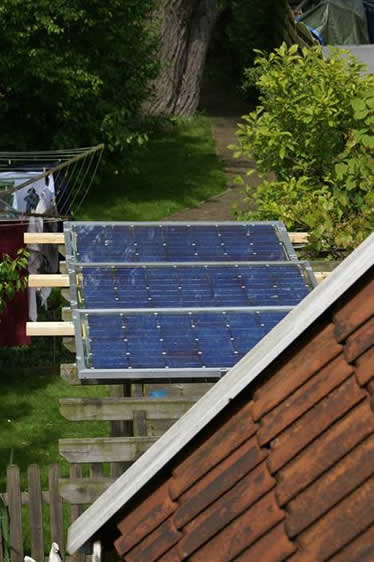
The 3 panels harvesting the sun.
Future thoughts
My future plan is first testing the panels for their durability as so far I mainly focused on making the panels and do I not really know what they will do after being exposed to the weather for a long period of time. After this it’s time to make a sun tracker and make more panels but than bigger ones. Than the panels will give more output due to the size and will always be facing under the right angle to the sun for maximum output. And it speaks for it self that all gained knowledge will be published on the site for everyone to access.
And for the critic, yes you’re right this is not free electricity as I had to pay for the parts but when I reached the breakeven point the costs are paid back and then the system will give me free energy by harvesting the sun.
To share my experiences I’ve made a website where you can see for yourself how I did it, my production records to show how the system is behaving, and how you can do this yourself by means of text, photo’s and films.
Why wait till tomorrow if you can start saving money today?
The content & opinions in this article are the author’s and do not necessarily represent the views of AltEnergyMag
Comments (0)
This post does not have any comments. Be the first to leave a comment below.
Featured Product

